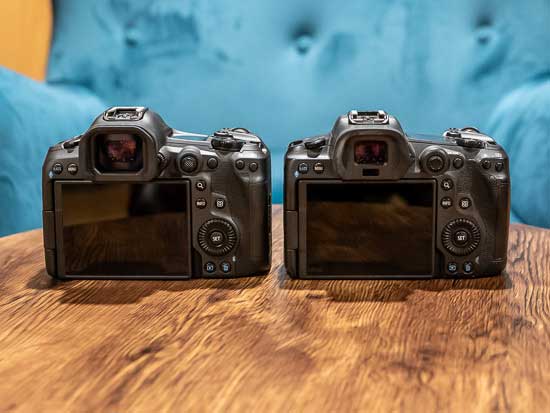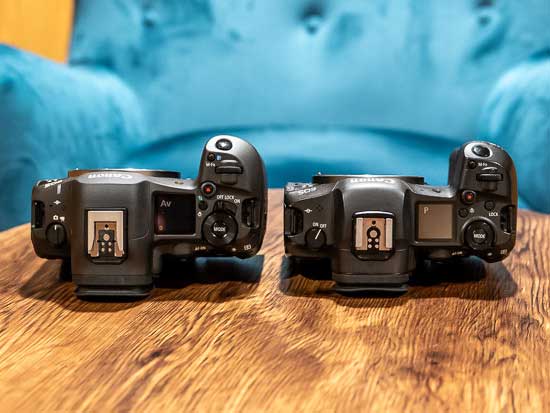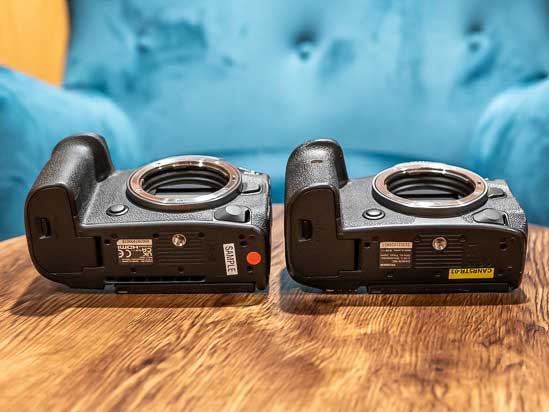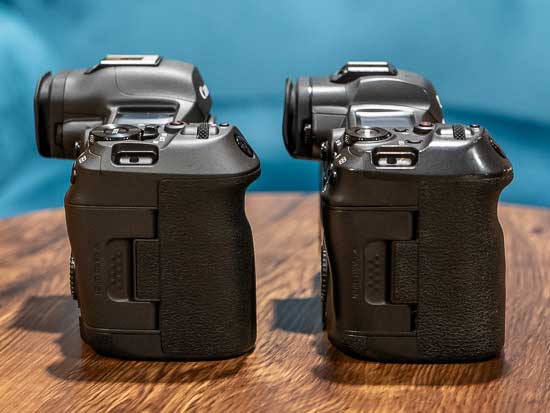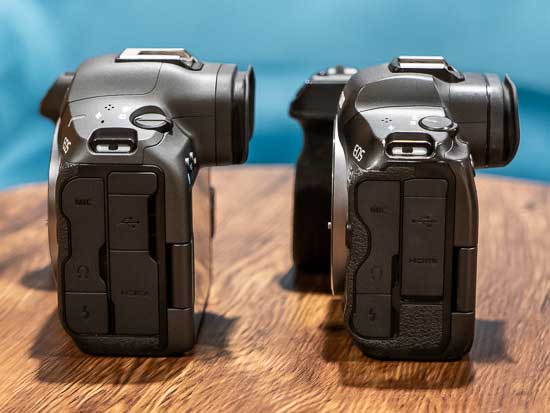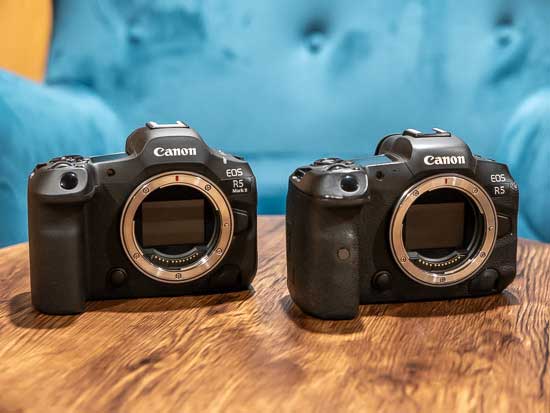
The Canon EOS R5 was first announced on July 9th, 2020, while the Canon EOS R5 Mark II was announced on 17th July 2024. Both are high-resolution, 35mm full-frame, hybrid mirrorless cameras aimed at prosumers.
Now that we know everything about the new Canon EOS R5 Mark II and the original R5, it’s clear that they actually share a lot of similarities when it comes to their core specifications and features, so which one should you pick?
We’re bringing you this in-depth Canon EOS R5 Mark II vs Canon EOS R5 head-to-head comparison to help you choose between these two full-frame mirrorless cameras.
You can also read our Canon EOS R5 Mark II review and Canon EOS R5 review to find out exactly what we think of each one in more depth.
Sensor and Processor
These two cameras offer the same number of megapixels, but they crucially use different processors that make a difference in image quality and especially performance.
The Canon EOS R5 Mark II uses a 45 megapixel stacked BSI CMOS image sensor, which is brand new for this particular camera, paired with the very latest DIGIC X and DIGIC Accelerator dual image processors..
The Canon R5 also has a 45 megapixel stacked BSI CMOS sensor that works in tandem with a single DIGIC X processor.
The new ‘Accelerated Capture’ imaging platform on the Mark II R5 supports the processing of large volumes of data, alongside Deep Learning technologies.In turn this unlocks higher performance and improved auto focusing, continuous shooting and image quality.
ISO Range
The native ISO range of both cameras runs from 100-51,200, which can be further expanded down to ISO 50 and up to ISO 102,400.
Pixel Shift Multi Shooting
The Canon R5 has a special multi-shot shooting mode in which it takes 16 different images which can be combined to produce a single, 400-megapixel JPEG image.
Note that this mode only works by keeping the camera absolutely still and for non-moving subjects.
In stark contrast, the new Canon EOS R5 Mark II doesn’t have any such equivalent mode.
Video Recording
The Canon R5 Mark II can record 8K 60p RAW video in-camera, plus 4K 120p, 4K 60p oversampled from 6K, and 2K or Full HD at 240p in XF-HEVC S / XF-AVC S formats.
It offers 16+ stops of dynamic range, minimal rolling shutter, Canon Log-2 / Log-3 / HLG profiles, custom pictures, proxy movie support and 4-channel 24-bit audio.
You can also shoot video and stills at the same time on the EOS R5 Mark II, even whilst using continuous shooting.
It has a full size HDMI port, whereas the original R5 has a micro-HDMI port.
The Canon EOS R5 offers 8K internal video recording up to 30p (non-cropped) in 4:2:2 10-bit Canon Log (H.265) or 4:2:2 10-bit HDR PQ (H.265), in addition to 4K video at up to 120p.
One key video difference between the two cameras is that the R5 II can record 8K/60p for up to 120 minutes, while the EOS R5 can only record 8K/30p for up to 20 minutes before it overheats.
Shutter Speeds
Both cameras have a top shutter speed of 1/8000th second via either its electronic or mechanical shutters.
Burst Shooting
The Canon EOS R5 can capture images at up to 20fps with the electronic shutter or 12fps with the mechanical shutter for 170 JPEG frames, 83 RAW or 130 Compressed C-RAW files.
If you want even faster burst shooting, though, the Canon EOS R5 Mark II ups the ante further by being able to shoot at up to 30fps with the electronic shutter or 12fps with the mechanical shutter for 200 JPEG frames or 93/86 (CFexpress/SD card) RAW images.
Pre-continuous shooting up to 15 frames (Raw or JPEG/HEIF) before fully pressing the shutter button is additionally available on the Mark II.
Autofocus
The Canon R5 employs the Dual Pixel CMOS AF system with a whopping 5,940 individual phase detection points that cover the frame up to 100% vertically and horizontally using the Auto AF area selection.
Impressively the EOS R5 can also focus in light levels as low as -6EV (when used with an F1.2 lens), but the Canon EOS R5 Mark II can focus in light levels as low as -6.5EV.
The EOS R5’s deep-learning AI can recognise cats, dogs and birds, focusing on their bodies, faces or eyes, plus vehicles including motorbikes and racing cars.
The new Dual Pixel Intelligent AF system featured on the R5 II offers an advanced tracking algorithm that can detect subject crossing/upper half of body and avoid obstacles by estimating the head area.
The new Action Priority subject tracking mode uses deep learning tech for football, basketball and volleyball to detect where the action is and move the AF point to that subject at up to 60fps. It can quickly detect and identify multiple people, status of joints and ball positions and automatically determine the main subject and action poses, depending on the sport.
Subject tracking can now recognise horses, aeroplanes and trains in addition to people, animals and motorsport vehicles when shooting both photo and videos.
The Registered People Priority mode can detect and prioritise up to 10 faces even in side profile, useful for sports, news and weddings, with the ability to save 10 files on a memory card each with 10 registered faces.
The R5 II’s eye control AF feature lets you select focus points or subjects to track simply by looking at them in the electronic viewfinder.
Compared to the R3 model on which this feature first made its debut, eye control AF on the R5 Mark II offers improved performance thanks to a higher pixel count sensor, improved LEDs, larger eye detection area, an updated detection algorithm, and 2x faster eye movement detection speed.
Body and Design
The new Canon EOS R5 Mark II and 2020’s Canon EOS R5 outwardly look very similar at first glance. The new version has a slightly more angular, sculpted design than the previous model.
The On/Off dial on the top-left of the R5 has been replaced with Stills/Video switch on the R5 II. The On/Off function has now been integrated into a new switch over on the top-right of the camera which also incorporates the Lock feature.
The new R5 II measures 138.5 x 101.2 x 93.5 mm and weighs 656g body only and 746g with a memory card card and battery fitted.
The original R5 measures 138.5 x 97.5 x 88mm and weighs 650g body only and 738g with a memory card card and battery fitted.
Weather Resistance
The magnesium alloy bodies of both cameras have excellent weather-sealing that is similar to the Canon EOS 6D Mark II’s protection, so not quite on the same level as the flagship EOS R1 or EOS-1D X Mark III cameras.
IBIS
The Canon R5 has a pretty incredible stabilisation system, with 5-axis in-body image stabilisation (IBIS) which provides up to 8 stops of compensation when using the camera with certain compatible lenses.
The R5 II is even slightly better again, offering up to 8.5-stops of image stabilisation.
Viewfinder
Both cameras use the same very impressive 5.76M-dot OLED electronic viewfinder with 0.76x magnification and a fast 120fps refresh rate.
LCD Screen
Both models have a a familiar 3.2-inch LCD panel with 2.1 million dots of resolution. It’s a fully articulating screen that can be flipped out to the side, rotated to the front, and folded against the back of the camera to help protect it.
Memory Cards
Both the Canon EOS R5 Mark II and the Canon EOS R5 have one UHS-II SD card slot and one ultra-high speed CFexpress Type B slot.
The memory card format is an important part of using these camera, supporting the 8K video recording, burst shooting and speedy performance, so you ideally need to use a CFexpress card that supports in excess of 1500Mbps write speeds to get the best out of them.
Battery Life
The Canon R5 uses the LP-E6NH battery which offers a lifespan of 470 shots when using the electronic viewfinder and 490 shots when using the LCD monitor.
The R5 II uses a new battery – the LP-E6P – which is required for some of the new video and burst shooting features.
Both cameras can still be used with an optional battery grip if you’d prefer to have a larger body with portrait controls and extended battery life.
Price
The Canon EOS R5 Mark II is priced at £4499 body only in the UK and €5149 in Europe.
This is only slightly more expensive than the Canon EOS R5 was at launch, which retailed for around £4299 body only in the UK and $3399 in the US.
Conclusion
The new Canon EOS R5 Mark II takes almost everything that we loved about the original model and, thanks largely to the new dual processors, improves almost every area, from auto-focusing to burst shooting and video performance. The original R5 is still a great camera though despite being 4 years old and is well worth seeking out if you don’t need the extra bells and whistles offered by the Mark II version.
So what do you think? Would you choose the new Canon EOS R5 Mark II or the Canon EOS R5, and why? Leave a comment below!
Your Comments
Credit : Source Post


